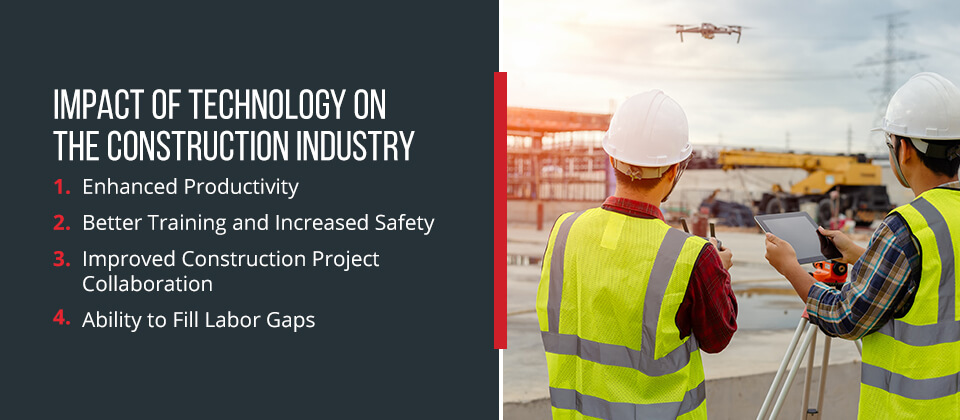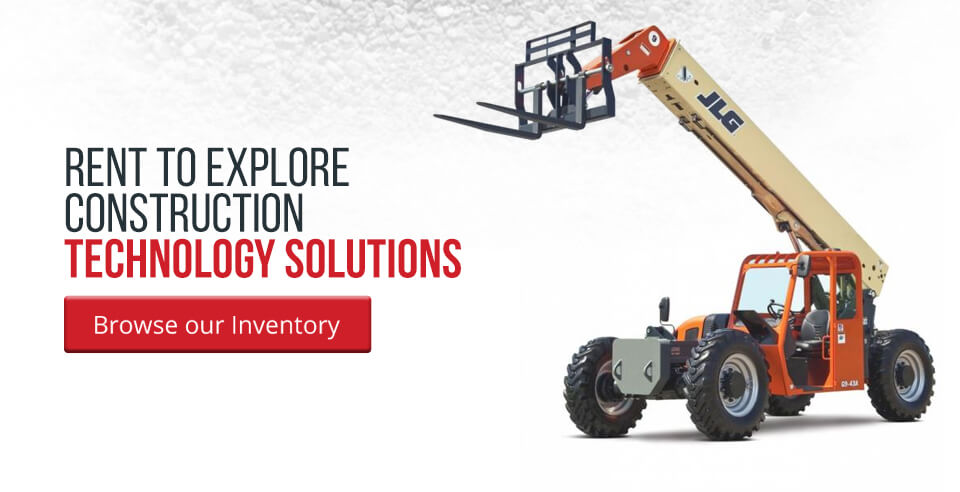How Has Technology Affected the Construction Industry?

The construction industry has rapidly evolved since its start, moving from completely manual work to tasks assisted by machinery. The new technology in construction is revolutionizing how the industry operates, helping boost productivity, improve worker safety and alter how people communicate about construction projects.
Below, you’ll learn about how technology is used in construction, the impact of technology on the construction industry, and how you can take advantage of these innovations to revolutionize your business.
What Is Construction Technology?
Construction technology refers to the collection of tools, machinery, software and modifications that construction companies use during a project to help advance various construction methods. Construction technology often uses semi-automated and automated equipment to complete construction projects, reducing manual workload and improving safety and productivity.
Technology that seemed like a dream is now a reality, such as 3D printing, automated heavy equipment, robots, drones and virtual reality (VR). Construction technology also includes preconstruction technology, such as bid management apps, online bid boards and digital takeoff solutions.

Impact of Technology on the Construction Industry
Construction companies that use technology to streamline their operations can enjoy the following benefits.
1. Enhanced Productivity
One of the main ways technology is changing the construction industry is by enhancing productivity on job sites. The traditional construction method of coming up with a design, biding with construction companies and proceeding to the building process can be inefficient and disjointed. Every construction site is unique and comes with its own risks and challenges, making maximizing productivity challenging.
Some new technology that’s making it easier to enhance productivity on the jobsite includes:
- Mobile apps and software: Various apps and software solutions help construction companies manage their construction projects. For example, there are scheduling, field reporting and preconstruction software options to help improve productivity and streamline your construction processes. Many apps and software are also cloud-based, allowing contractors to access and update their information in real time whenever needed. Apps and software also improve communication between workers and project managers.
- Offsite construction: Offsite construction refers to manufacturing most or all of a project offsite before transporting it to the final location, sometimes called prefabrication or modular construction. Offsite construction is typically done when multiple repetitive floorplans exist, usually for apartments, hospitals, dorms and hotels. Offsite construction is an innovation that can help boost productivity by reducing labor onsite and allowing workers constant access to the tools they need to perform their work.
- Artificial intelligence (AI) and machine learning: AI technology is helping construction companies make more informed decisions, which is increasing productivity by reducing risks and providing the best solution for unique challenges and risks.
2. Better Training and Increased Safety
New construction technology is making training employees about proper safety and equipment operation easier. This technology also helps improve worker safety, partially by allowing automation and robotics to take over dangerous jobs and by developing VR, smart wearables and other technology.
Safety should be a construction company’s top priority, so contractors must take advantage of new safety and training innovations as they’re developed and released. Some of the technology that is improving safety and training procedures on construction sites includes:
- VR: VR can help workers gain exposure to specific environments in a safe and controlled environment, such as high working heights or confined spaces. VR can also train workers in crane operation, welding, masonry and other tasks.
- Wearables: Wearable technology can monitor the environment and workers to improve job safety. This technology can be embedded into workers’ construction equipment and clothes, such as hard hats or protective vests. It can utilize sensors, GPS, voltage detectors and Wi-Fi to help detect accidents, falls or other dangerous conditions. This technology can even alert workers to potentially hazardous situations to help prevent an accident or injury.
- Site sensors: Construction companies can utilize site sensors to monitor various things at a worksite, including temperature, volatile organic compounds, dust particles and noise levels to help reduce exposure to workers. These sensors can alert workers so they can react immediately to a potential hazard, helping improve safety at the worksite.
3. Improved Construction Project Collaboration
Many people are involved in construction projects, including engineers, designers, contractors and equipment distributors. It can be challenging to get everyone on the same page quickly, but innovations in technology have made collaborating on construction projects easier than before.
Some of the technology that is helping improve collaboration includes:
- Mobile technology: Mobile apps and smartphones have made communication on construction projects easier than ever before. Mobile technology allows meetings to be held virtually rather than having to gather everyone at an office. Having the ability to communicate in real time, regardless of where everyone is located, can help speed up projects and reduce miscommunication among different teams involved.
- Building information modeling (BIM): BIM utilizes 3D models of buildings to help improve collaboration and the design and construction of a project. Any changes to your BIM model will occur in real time, so your team members will have an updated model, allowing everyone to work with the most recent data available. BIM can also be used alongside VR, allowing you to view the environment to better understand how it will look at the end of the project.
4. Ability to Fill Labor Gaps
Labor shortages have been a problem in the construction industry for years. While the industry has experienced growth through increasing demand, there aren’t as many workers available to keep up with that demand.
The good news is technological innovations have made it possible to fill these labor gaps until more workers enter the industry, which includes:
- Drones: Drones have many applications on construction sites, including conducting jobsite inspections, identifying hazards, monitoring worker safety and taking photos of project progression. Drones can also help with dangerous jobs like building or bridge inspections. Drones won’t eliminate the need for workers but will require workers to have the training to perform these tasks.
- Robotics: Currently, robots can do repetitive tasks like tying rebar or laying bricks. These robots can work throughout the day without needing a break or time for sleep. While robots can handle some of the job, humans are still required for other tasks, including setting up robots, getting them started and overseeing the work.
- Automated heavy equipment: This technology is similar to what’s found in self-driving cars and can perform site work, grading and excavations on construction sites. These machines utilize various technologies, including drones, sensors and GPS, to navigate and complete tasks on a construction site.
Rent to Explore Construction Technology Solutions
If you’re looking for heavy equipment for your construction project, Chicago Industrial Equipment has you covered. We offer a wide range of lift equipment, including boom lifts, industrial forklifts, telehandlers and more. Renting our equipment can help you decide what technology can benefit your construction company the most.
Our equipment is inspected and serviced in-house, ensuring you get high-quality equipment you can trust. Contact us today to learn more about how we utilize technology in our equipment and how you can benefit by renting from us.


